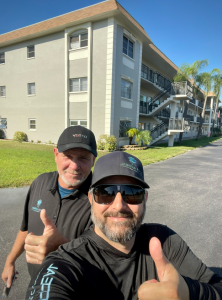What Type of Paint Is Best for Florida’s Humid Climate?





 Living in Florida comes with many perks—sunshine, palm trees, and beautiful coastal views. But if you’re a homeowner planning to refresh your property with a new coat of paint, you’re probably already aware of one of Florida’s biggest challenges: humidity. Choosing the right paint in this climate isn’t just about aesthetics—it’s about performance and longevity. A knowledgeable Painting Contractor Palm Harbor FL will always factor in Florida’s unique climate conditions when recommending the best products for your home.
Living in Florida comes with many perks—sunshine, palm trees, and beautiful coastal views. But if you’re a homeowner planning to refresh your property with a new coat of paint, you’re probably already aware of one of Florida’s biggest challenges: humidity. Choosing the right paint in this climate isn’t just about aesthetics—it’s about performance and longevity. A knowledgeable Painting Contractor Palm Harbor FL will always factor in Florida’s unique climate conditions when recommending the best products for your home.
In this comprehensive guide, we’ll explore the types of paint that stand up best to high humidity, intense UV rays, heavy rain, and salt air. We’ll also cover key considerations for both interior and exterior applications, and offer expert tips to ensure your home stays vibrant and protected for years to come.
Why Florida’s Climate Demands Specialized Paint
Florida is notorious for its tropical and subtropical climate. This means homes are subjected to:
- High humidity levels year-round
- Frequent heavy rainfall
- Blazing sun and intense UV exposure
- Salty coastal air in many areas
- Rapid temperature fluctuations
These environmental conditions can wreak havoc on standard paint products. Without the right type of paint and proper application, even a fresh paint job can peel, blister, or fade within months.
Key Qualities to Look for in Paint for Florida Homes
Whether you’re tackling an exterior or interior paint job, you’ll want to choose products that are specifically formulated to perform in hot, humid environments. Here are the key features to prioritize:
1. Mildew and Mold Resistance
Florida’s moisture-laden air is a breeding ground for mold and mildew, especially in shaded areas or spots that retain moisture. Look for paints that contain mildewcides—additives that prevent fungal growth.
2. UV Protection and Fade Resistance
Constant exposure to the sun can fade colors and degrade paint binders. High-quality exterior paints for Florida should contain UV-blocking pigments that keep your color vibrant and durable.
3. Water Resistance
Paint that forms a waterproof or water-repellent film is essential for keeping Florida’s frequent rainstorms from soaking into siding or stucco. This is particularly crucial for wood surfaces.
4. Breathability
Especially for stucco and concrete surfaces, it’s important that the paint allows moisture to escape while still repelling water. This helps prevent paint bubbling and delamination.
5. Flexible and Durable Film
Because of rapid temperature changes and high humidity, Florida homes need paint with a flexible, durable finish that can expand and contract without cracking.
Best Exterior Paints for Florida’s Humidity
1. 100% Acrylic Latex Paint
This is the gold standard for exterior painting in Florida. Acrylic latex is:
- Highly breathable, reducing moisture-related issues
- Resistant to UV damage
- Quick-drying, minimizing the window for humidity to interfere
- Durable and flexible, standing up to cracking and peeling
Most professional Painting Contractors in Palm Harbor FL recommend premium acrylic latex products for wood, stucco, concrete, and siding surfaces.
Recommended Brands:
- Sherwin-Williams Duration or SuperPaint
- Benjamin Moore Aura Exterior
- Behr Premium Plus Ultra Exterior
2. Elastomeric Paint (for Stucco or Masonry)
Elastomeric coatings are ultra-thick paints that stretch and bridge hairline cracks. They’re perfect for:
- Waterproofing stucco walls
- Handling thermal expansion
- Coastal homes prone to salt air exposure
However, elastomeric paints are less breathable, so they’re best used in very specific conditions and typically applied by experienced contractors.
Best Interior Paints for High-Humidity Areas
In Florida, it’s not just the exterior that suffers from moisture—interior areas like bathrooms, kitchens, and laundry rooms are also at risk. Choosing the right interior paint is essential for keeping walls mold-free and easy to maintain.
1. Acrylic Latex Interior Paint
Much like exterior use, interior acrylic latex is the most reliable choice. It dries quickly, resists moisture, and cleans up easily.
2. Paints with Anti-Microbial Additives
Opt for brands that incorporate mold-resistant additives. These are especially valuable for bathrooms or homes without central dehumidification systems.
3. Choose the Right Sheen
In humid interiors, satin, semi-gloss, or gloss finishes are preferable over flat paints. They:
- Repel moisture better
- Are easier to wipe down
- Offer better resistance to staining and mildew
Recommended Brands:
- Benjamin Moore Aura® Bath & Spa (specially formulated for steamy areas)
- Sherwin-Williams Emerald Interior Acrylic Latex
- Zinsser Perma-White Mold & Mildew-Proof Interior Paint
Paint Additives to Consider
In Florida’s climate, sometimes you need an extra layer of defense. Ask your painting contractor about:
1. Mildewcide Additives
Can be mixed into standard paints to enhance mold resistance—especially useful if you’re repainting older homes or wood structures.
2. UV Protectants
While most high-quality paints already include UV protection, additional UV stabilizers can be added for intense sun exposure areas.
Pro Tips for Painting in Humid Climates
1. Time Your Project Strategically
Humidity can delay drying time and interfere with adhesion. Ideal painting days in Palm Harbor are:
- Low humidity (below 70%)
- Temps between 50°F and 85°F
- No rain forecasted for 48 hours
2. Prep Thoroughly
- Pressure wash all exterior surfaces to remove mildew and dirt.
- Allow surfaces to dry completely before painting.
- Use primer where necessary, especially on raw or patched surfaces.
3. Work with Experienced Professionals
A trusted Painting Contractor in Palm Harbor FL will know how to:
- Choose paint based on your exact location (coastal vs inland)
- Apply it in the right weather conditions
- Use proven methods to ensure long-term adhesion and protection
Common Mistakes to Avoid
Even with the right products, incorrect application can ruin a paint job. Here’s what NOT to do:
- Painting during high humidity or rain
- Skipping surface preparation
- Using interior paint for exterior applications
- Choosing the cheapest paint option (low-cost paints often lack UV protection or mold resistance)
Is Eco-Friendly Paint a Good Choice in Florida?
Yes, but with caveats. Many low-VOC and eco-friendly paints now include the same weather-resistant and anti-microbial features as traditional paints. However, always check for:
- Moisture resistance
- UV durability
- Longevity ratings
Choose eco-friendly options from reputable brands like Sherwin-Williams, Benjamin Moore, or Behr.
Coastal Considerations for Paint Longevity
If you’re in a waterfront or near-coast neighborhood in Palm Harbor:
- Use marine-grade or salt-resistant paints
- Wash your exterior walls regularly to remove salt deposits
- Apply sealants over the paint to extend lifespan
Salt exposure can erode standard coatings quickly, so invest in higher-end materials and protective finishes.
Choose Smart, Paint Smarter
When it comes to painting your Florida home, especially in a climate like Palm Harbor’s, choosing the right paint is not optional—it’s essential. From mold resistance to UV stability, the type of paint you use plays a significant role in how long your home stays beautiful and protected. Partnering with a reputable Painting Contractor Palm Harbor FL ensures that you’re not only choosing the right products but also applying them correctly, for maximum longevity and visual appeal.
Next Up:
Curious about how often you should repaint your home’s interior in Palm Harbor? Stay tuned for our next article, How Often Should I Repaint My Home’s Interior in Palm Harbor?, where we’ll break down timelines by room type, paint quality, and Florida-specific factors.

100% Satisfaction Guarantee

Licensed and Insured

Color Consultation

3 Year Warranty
Services

Our team of experts does popcorn ceiling removal and wallpaper removal. We also do drywall and stucco repairs as well as texturing, soffit and fascia repair.
Painting Service Locations

How long does it take to paint my house?
What is included with your free estimate?
All of our estimates include a fully detailed scope of the work to be completed. You will receive a report with a breakdown of the cost and time estimated for your project.
How do I get my project scheduled?
Simply follow the steps in the estimate to schedule or give us a call, text, or email. Whichever is convenient for you works for us.
Why does a house have to be pressure washed before painting?
If you’re planning to paint the exterior of your home, you may be wondering why pressure washing is such an important step. After all, a little dirt and grime shouldn’t stop the paint from sticking, right? Unfortunately, it’s not that simple. Over time, dirt, mildew, and other pollutants can build up on the surface of your home, causing the paint to chip and peel. Pressure washing removes this build-up, giving the new paint a clean surface to adhere to. In addition, pressure washing also helps to remove any chalky residue left behind by old paint. This ensures that the new paint will have a smooth, even finish. For these reasons, it’s always best to have your home professionally pressure washed before painting
Item How often does a house need to be repainted?
The frequency with which a house exterior needs to be repainted depends on a number of factors, including the type of paint used, the climate, and the level of exposure to sun and rain. In general, however, most experts recommend repainting every three to five years. High-quality paints that are properly applied can last for about 10 years, while lower-quality paints may last less. The climate also plays a role in how often a house needs to be repainted. For example, homes in areas with high humidity levels may need to be repainted more frequently than homes in dry climates. Exposure to sun and rain can also shorten the lifespan of paint, so homes that are exposed to these elements may need to be repainted more often than those that are not. Ultimately, the best way to determine how often a house exterior needs to be repainted is to consult with a painting contractor who can assess the condition of the paint and make a recommendation based on individual circumstances.
Trustindex verifies that the original source of the review is Google. I want to thank Curb Appeal Pros for doing an amazing job of painting the exterior of my house. Sending a big shout out to owner, Jay McGarrity, for being so patient, professional, and fair with the pricing, timing, and color choices. When I changed my mind about the original colors that I had selected, Jay came back to my house twice (including Father's Day) to test some different paint samples I had purchased from Sherwin Williams. The final result was exactly what I wanted and my house looks fabulous! I will hire Curb Appeal Pros again when I am ready to have some interior painting done.Trustindex verifies that the original source of the review is Google. They repaired stucco on the fireplace exterior and outside window sills, pressure washed the house, and my shed in the backyard. Painted the house and all fascia and soffits. They did an outstanding job !! Would not hesitate to use them again.Trustindex verifies that the original source of the review is Google. Amazing job filled in all the settling cracks and made the house look amazing would highly recommend them to anyone who’s looking to fix their home up.Trustindex verifies that the original source of the review is Google. What a great experience. Joey worked with me to get the house painted in between projects so I could have the house painted before my new gutters were put in. I didn't have to be home, which was a plus. The painter Angel and Nathen which I got meet at the end of the project were friendly and professional. I would definitely recommend Curb Appeal. Joyce Walter.Trustindex verifies that the original source of the review is Google. We recently hired Curb Appeal Pros to paint our living room,dining room, family room and kitchen. They were easily up to the task. I had different colors,different paint finish’s, texturing and an accent wall as well. Angel and his crew did an amazing job.They were organized ,pleasant ,and had my entire house finished in less than 3 days. They removed all the large furniture and carefully put it back in its place perfectly after the job was done ! The owner was hands on and was easy to reach and made sure that my questions were answered without delay or hesitation. My house looks amazing . They went the extra mile in every way and we are so grateful . Thank you Curb Appeal for a job well done. I recommend you contact them for all your painting needs.Trustindex verifies that the original source of the review is Google. Curb Appeal Pros is a 'one stop shop'. They recently painted our house and installed ledger stone on the exterior of our house. After the job was completed, we contacted Jay McGarrity about a detail. Jay immediately responded and came back to the house even after payment! The end result of their work is beautiful. Jay and his Team are a pleasure to work with.Trustindex verifies that the original source of the review is Google. reliable, great work, honest pricing. i highly recommend these pplTrustindex verifies that the original source of the review is Google. Fair price and good work. What more can you ask for?Trustindex verifies that the original source of the review is Google. Excellent job. Jay was quick to respond to everything we asked, kept us well informed and made sure the job was done exactly how we asked. Will definitely recommend to everyone who asks, which we have already done several times as of this review. Truly thankful for the professionalism when so many companies now lack it!
Request An Estimate

copyright @2025 all rights reserved | Privacy-policy